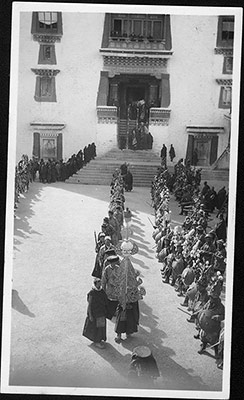
1999.23.2.19 (Print black & white)


1999.23.2.19 (Print black & white)

H. Staunton ?
Harry Staunton
1940 - 1941 [February]
Lhasa > Potala > Deyang shar
1999.23.2.19
65 x 110 mm
Ritual Activity
Print gelatin silver
Donated 1999
Diana Hughes
H. Staunton
Diana Hughes
Notes on print/mount - "Devils images to be cast away" is written in pencil on the reverse of the print. 511 is stamped on the back in black ink.
Other Information - Setting: Hugh Richardson ( Ceremonies of the Lhasa Year, 1993, London: Serindia Publications, p. 116) describes the setting for this photograph thus:"...the great eastern courtyard of the Potala, the Deyang Shar. It is entered by a long, steep, triple stair below which is a well-proportioned flight of stone steps. The wide central windows of the facade above are hung with bright valances; the uppermost, curtained with yellow silk, is that of the private room of the Dalai Lama from which he may watch the dances; the two below are for the Kashag and other senior officials respectively. On the north side of the courtyard a long canopy... shelters the padded seats for the monk orchestra. An open parapet above it provides a viewpoint for spectators as does a similar parapet to the south beneath which there are galleries for ladies and other distinguished persons. Towering over the east end is a massive three-storied building reached by a long stone stairway from the Sho. At one side is a balcony for lesser officials and the central windows are reserved for foreign visitors."
Other Information - Military: Hugh Richardson ( Ceremonies of the Lhasa Year, 1993, London: Serindia Publications, p. 116) describes the setting for this photograph thus: "Then they [traditional foot soldiers, zimchongpa ] have displayed their skill, at some length,with their differing weapons to the accompaniment of shrill trumpeting, battle cries, taunts and chanting, ending with a loud explosion of musketry, they sit in the courtyard to receive their reward of tea and meat, and then withdraw to the sides." There is more information about the traditional foot soldiers in ibid. p.49.
Other Information - Ritual Object: The votive offering, in which all evil influences are stored, is cast out ritually at various ceremonies. It is taken to an open space outside the temple/monastery precincts where it is destroyed by having arrows shot at it and then being burnt. [KC 21/10/2005]
Other Information - Related Images: 1999.23.1.15.4, 1999.23.1.18.1/2/3/4, 1999.23.2.47 [KC 29/11/2005]
For Citation use:
The Tibet Album.
"Monks with votive offering in the Potala eastern courtyard "
05 Dec. 2006. The Pitt Rivers Museum.
<http://tibet.prm.ox.ac.uk/photo_1999.23.2.19.html>.
For more information about photographic usage or to order prints, please visit the The Pitt Rivers Museum.
© The Pitt Rivers Museum